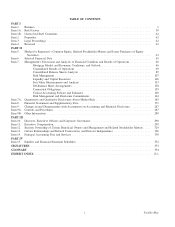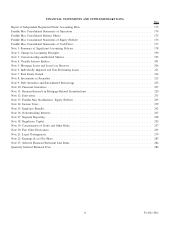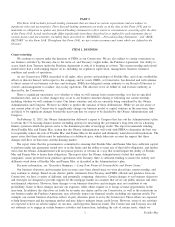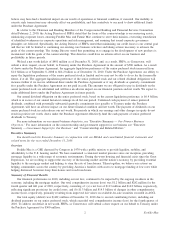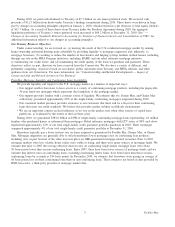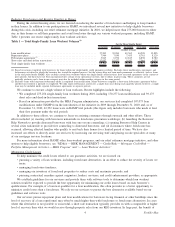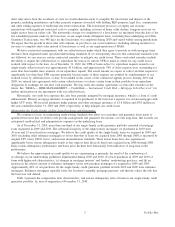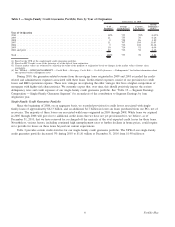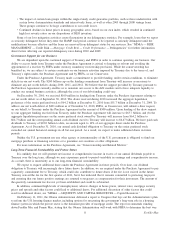Freddie Mac 2010 Annual Report Download - page 12
Download and view the complete annual report
Please find page 12 of the 2010 Freddie Mac annual report below. You can navigate through the pages in the report by either clicking on the pages listed below, or by using the keyword search tool below to find specific information within the annual report.to responsibly reduce the role of Freddie Mac and Fannie Mae in the market and ultimately wind down both institutions. The
report states that these efforts must be undertaken at a deliberate pace, which takes into account the impact that these
changes will have on borrowers and the housing market.
The report states that the government is committed to ensuring that Freddie Mac and Fannie Mae have sufficient capital
to perform under any guarantees issued now or in the future and the ability to meet any of their debt obligations, and further
states that the Obama Administration will not pursue policies or reforms in a way that would impair the ability of Freddie
Mac and Fannie Mae to honor their obligations. The report states the Obama Administration’s belief that under the
companies’ senior preferred stock purchase agreements with Treasury, there is sufficient funding to ensure the orderly and
deliberate wind down of Freddie Mac and Fannie Mae, as described in the Administration’s plan.
The report identifies a number of policy levers that could be used to wind down Freddie Mac and Fannie Mae, shrink
the government’s footprint in housing finance, and help bring private capital back to the mortgage market, including
increasing guarantee fees, phasing in a 10% down payment requirement, reducing conforming loan limits, and winding down
Freddie Mac and Fannie Mae’s investment portfolios, consistent with the senior preferred stock purchase agreements.
These recommendations, if implemented, would have a material impact on our business volumes, market share, results
of operations and financial condition. We cannot predict the extent to which these recommendations will be implemented or
when any actions to implement them may be taken. However, we are not aware of any current plans of our Conservator to
significantly change our business model or capital structure in the near-term.
Changes in Accounting Standards Related to Accounting for Transfers of Financial Assets and Consolidation of VIEs
In June 2009, the FASB issued two new accounting standards that amended the guidance applicable to the accounting
for transfers of financial assets and the consolidation of VIEs. Effective January 1, 2010, we adopted these new accounting
standards prospectively for all existing VIEs. The adoption of these two standards had a significant impact on our
consolidated financial statements and other financial disclosures beginning in the first quarter of 2010. As a result of our
adoption of these standards, our consolidated balance sheets reflect the consolidation of our single-family PC trusts and
certain of our Other Guarantee Transactions. This consolidation resulted in an increase to our assets and liabilities of
$1.5 trillion and a net decrease to total equity (deficit) as of January 1, 2010 of $11.7 billion.
Because our results of operations for the year ended December 31, 2010 (on both a GAAP and Segment Earnings basis)
include the activities of the consolidated VIEs, they are not directly comparable with the results of operations for the years
ended December 31, 2009 and 2008, which reflect the accounting policies in effect during that time (i.e., when the majority
of the securitization entities were accounted for off-balance sheet).
See “NOTE 2: CHANGE IN ACCOUNTING PRINCIPLES” for more information regarding the new accounting
standards and the impact to our financial statements.
Consolidated Results — 2010 versus 2009
Net loss was $14.0 billion and $21.6 billion for 2010 and 2009, respectively. Key highlights of our financial results for
2010 include:
• Net interest income for 2010 decreased slightly to $16.9 billion from $17.1 billion in 2009, mainly due to a decrease
in the average balance of mortgage-related securities, partially offset by lower funding costs.
• Provision for credit losses for 2010 decreased to $17.2 billion from $29.5 billion for 2009. The provision for credit
losses in 2010 primarily reflects a substantial slowdown in the rate of growth of our non-performing single-family
loans. The provision for credit losses in 2009 reflected significant increases in non-performing loans and serious
delinquency rates in that period.
• Non-interest income (loss) was $(11.6) billion for 2010, compared to $(2.7) billion for 2009. This decline was
primarily due to higher derivative losses, lower gains on investment securities, and a decrease in other income in
2010. Other income declined primarily due to a significant decrease in income recognized on our guarantee activities,
which was substantially eliminated as a result of our adoption of the new accounting standards for consolidation of
VIEs on January 1, 2010. These declines were partially offset by reduced impairments of available-for-sale securities
in 2010, compared to 2009.
• Non-interest expense declined to $2.9 billion in 2010, compared to $7.2 billion in 2009, primarily due to lower losses
on loans purchased, which was substantially eliminated as a result of our adoption of the new accounting standards
for consolidation of VIEs on January 1, 2010.
• Total comprehensive income (loss) was $282 million for 2010 compared to $(2.9) billion for 2009. Total
comprehensive income for 2010 reflects the net result of the $14.0 billion net loss for 2010, and an increase of
$14.3 billion in AOCI primarily resulting from fair value improvements on available-for-sale securities.
9Freddie Mac


